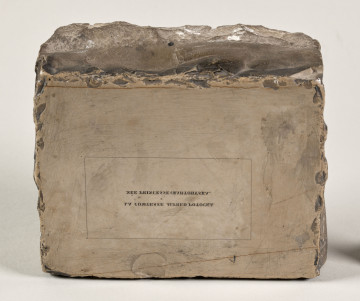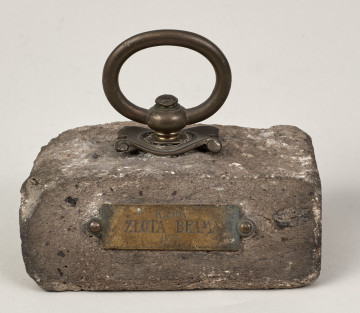
Paperweight
XIX century
Castle Museum in Łańcut
Part of the collection: Broń, instrumenty, varia
Human memory is unreliable, it is better to write down your thoughts so that they do not fly away. Writing is an art that is one of the milestones of human civilization.
All you need to write is a blank sheet of paper, a pen, ink (increasingly replaced by word processors, mice, etc.) and you can create the next national epic. To make it not too easy, the ink stains the sheets of paper, stains the fingers, but tissue paper can remedy this. Once we have dealt with the ink and stains, we sit down and "pour" our thoughts onto paper. We're sitting, we're writing with enthusiasm, and then someone walks in the room, opens the door, opens the window, and this treacherous wind blows the written and unwritten pages to the floor, mixing everything up. The poor creator had to pick them up, often on his knees, and his back hurts from sitting. When he has already collected the pages, it turns out that they are mixed up, and he forgot to number them and, to make matters worse, a few pages were forgotten during the collection and in fact they should be rewritten. Finally, we manage to put the written pages in order, and we sit down to continue our work, and then someone comes in again on an urgent matter, someone opens the second window and again we have confetti from our written pages and we start collecting our written "golden thoughts" from the beginning. After a few such visits, we forget our own thoughts, discouragement creeps in, and because of such a small zephyr, some "epoch-making" work may not be created. And yet it was enough (with the exception of locking the doors and windows) to hold the blank and written pages with some heavy object, but not so heavy as to destroy the sheets of paper. Such an object is a paperweight, which is sometimes a small work of art in the form of a figurine, a plaque made of alabaster or glass, or other materials that are pleasing to the eye. They can also be very simple elements, such as various types of stones collected during trips to places sentimentally close to the collectors or related to the history of family or country. In this way, the paperweight became an indispensable desk equipment next to the inkwell, pounce pot, tissue paper, pen holder, lamp, and just like them, it took on different forms and shapes depending on the fashion prevailing in art at a given period. Paperweights, thanks to their form/shape and the material they are made of, complement the décor of the desk – those made of wood evoke the impression of warmth, those made of metal, especially precious metals, add majesty, and those made of glass or crystal, thanks to reflections, give the character of ephemerality like written thoughts. The most ordinary ones in the form of stones remind us of the places we have been to. They can also remind us of past centuries and events that determine our history and heritage.
The discussed paperweights from the collection of the Museum – Castle in Łańcut come from the collection of the Potocki family, belong to the latter category and come from places currently outside the country (Borderlands) related to the history of Polish. One of them is the paperweight with the inv. no. 3612MŁ in the shape of a lying stone irregular cuboid with irregular edges and a round brass handle mounted on the to. The same material is used to make an elongated decorative plate decorated with a shell motif, attached to the stone without visible studs with the inscription "Stare Sioło 1872". Like most of the towns and castles of the former south-eastern Polish, now called Eastern Borderlands, it is closely related to the history of our homeland. The year 1221 according to the sources of Ukraine is the creation of the village, the next date in the sources is the year 1442 in which the Polish king Władysław II Jagiełło gave the settlement to the most famous Polish knight Zawisza the Black. A descendant of the knight brought Stare Sioło as a dowry to hetman Jan Tarnowski. After the Tarnowski family, the village and later the castle, became the property of Konstanty Ostrogski, Aleksander Zasławski, and then the property of the magnate families of Sieniawski, Lubomirski and Czartoryski (1731). The last magnate family of the Republic of Poland to rule the castle and the village (from 1809) were the Potocki family of the silver Pilawa coat of arms (Łańcut line), and the last was Alfred Antoni Potocki the fourth Ordynat of the Łańcut. The castle in Stare Sioło was built much later than the settlement and, according to sources, it was built in 1654 (another date 1642) by Władysław Dominik Ostrogski, and Ambroży Nutclauss (the Favorable), a Renaissance architect active in Lviv, was said to have participated in its creation. The castle, like the whole Borderlands, had a turbulent history - in 1648 it was partially destroyed by Khmelnytsky's army, but just a few decades later in 1672 it resisted the Turks. The Sieniawski family expanded the fortifications, placing one of their arsenals in it and arming it with cannons and mortars. In its heyday, the castle was one of the largest in the south-eastern lands of the Republic of Poland on the so-called Wołów route. To this day, the ruins of the castle are awe-inspiring. The total length of the walls is 500 m, the thickness of the walls is 2 m, the height is 15 – 16 m. If we add 6 towers, the area of 2 hectares, the castle gives an image of this majestic fortification. The following years saw a slow decline of the fortress, the decreasing importance of this type of fortification for defence, geopolitical changes and the use of the castle for a brewery and various types of warehouses. The destruction was completed in the post-war years when the castle housed a bakery, a warehouse for cattle bones and rooms for sauerkraut.
Traces of the last family ruling Stary Sioło (the Potocki family) can also be found in the church of Our Lady of the Snows and the Holy Trinity (1828-1835), where in 1923 stained-glass windows from the Żeleński factory in Cracow were installed. The stained-glass windows were ordered by Jerzy Potocki, the brother of the last Ordynat of Łańcut.
Thanks to such inconspicuous objects as this paperweight, the history of the nation and the national identity have been preserved.
Przemysław Kucia
Author / creator
Object type
pamiątki
Material
stone
Creation time / dating
Owner
Muzeum - Zamek w Łańcucie
Identification number
Location / status

XIX century
Castle Museum in Łańcut

XIX century
Castle Museum in Łańcut

XIX century
Castle Museum in Łańcut
DISCOVER this TOPIC
Museum of King Jan III's Palace at Wilanów
DISCOVER this PATH
Educational path